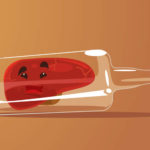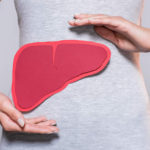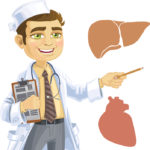
Previous
Veggies, Liver Health and Hepatitis A

Next
Green Tea Promotes a Lean Liver
The High Infection Risk Associated with Cirrhosis
British researchers reveal medically sound prevention for a common complication of cirrhosis. Discover why supplementing with probiotics can greatly reduce the risk of bacterial infection from ascites.
A major concern with chronic liver disease, livers subjected to repeated injury run the risk of developing cirrhosis. One of the more commonly encountered complications of cirrhosis is a high prevalence of bacterial infections. However, purposeful supplementation with probiotics can significantly lower a person’s susceptibility to infection.
Cirrhosis and Ascites
In cirrhosis of the liver, scar tissue replaces normal, healthy tissue, which blocks the flow of blood through the organ and prevents it from functioning properly. The twelfth leading cause of death by disease, cirrhosis kills approximately 26,000 Americans each year.
The most common problem resulting from cirrhosis, ascites is the accumulation of excess fluid in the abdomen. Experts estimate that cirrhosis is responsible for 80 percent of all cases of ascites in the United States. Cirrhotic patients are prone to developing spontaneous infections stemming from accumulated fluid occupying the abdominal cavity.
Infection
Dr. Rajiv Jalan, head of a research team from University College Hospital in London, presented intriguing pilot study results at the 2007 annual meeting of the American Association for the Study of Liver Diseases in Boston, Massachusetts. According to Jalan, “…cirrhosis is associated with the gut becoming more leaky. Bacterial products leak into the circulation and cannot be adequately cleared.”
Spontaneous bacterial peritonitis is an infectious form of peritonitis (inflammation of the abdominal cavity) that affects 10 to 30 percent of people hospitalized with ascites. Spontaneous bacterial peritonitis can cause:
· rapid acceleration of liver disease
· other complications
· sepsis (whole body infection)
· death
A dangerous result of fluid buildup in the abdomen, spontaneous bacterial peritonitis is the most common infection in patients with ascites from cirrhosis, and it strikes without any identifiable external source of infection.
Bacterial Translocation
Known to play an important role in spontaneous bacterial peritonitis, bacterial translocation is the suspected culprit. Defined by Stedman’s Medical Dictionary, bacterial translocation is: “the movement of bacteria or bacterial products across the intestinal membrane to emerge either in the lymphatics or the visceral circulation.”
Academics investigating the source of spontaneous bacterial peritonitis in those with ascites believe that the following contribute to bacterial translocation:
· Gut motility alterations – The fluid buildup of ascites applies pressure on the digestive system components, altering its physical capabilities.
· Bacterial overgrowth – As a rule, stagnant fluid promotes the overgrowth of bacteria.
· Changes in intestinal permeability – A prime example of osmosis, the fluid outside the intestines in ascites changes the permeability of the intestinal tissue. Increasing the likelihood of peritonitis, this facilitates the flow of bacteria from inside the intestines to outside of the intestines.
The human body is home to hundreds of billions of bacteria, many of which are vital for optimum health. When a person is in a state of health, the good and bad bacteria in the gastrointestinal system are balanced. In the case of spontaneous bacterial peritonitis from ascites, bacterial translocation causes the bad bacteria to overpower the beneficial gut microbes.
Probiotics
Researchers led by Jalan found that supplying good bacteria to people with liver cirrhosis reduced their risk of developing an infection like spontaneous bacterial peritonitis. Dubbed probiotics, the body’s good bacteria literally mean “for life.”
Certain probiotics help maintain good health while others help us regain health once it has been threatened. Although there are many functions probiotics serve, listed below are just a handful:
1. Probiotics actively produce antibacterial substances, which kill or deactivate hostile bacteria. They do this by changing local levels of acidity, depriving pathogenic (disease-causing) bacteria of their nutrients or by actually producing substances, which can kill invading bacteria, viruses and yeasts.
2. Some probiotic bacteria (such as bifidobacteria and acidophilus) have been shown to exhibit powerful anti-carcinogenic features, which are active against certain tumors.
3. Probiotics improve the efficiency of the digestive tract – when weakened, bowel function is poor.
4. They have been reported to effectively help reduce high cholesterol levels.
5. Probiotics help protect against radiation damage and deactivate many toxic pollutants.
Good bacteria are easy to obtain and have no reported adverse effects. Higher concentrations can be found in supplement form, while lower concentrations of probiotics are now showing up in commercially available foods. As their value becomes increasingly recognized, yogurt, cheese and even nutrition bars are boasting probiotics.
Jalan’s team supplied a probiotic yogurt to their study participants and found that this simple addition to a person with cirrhosis’ routine greatly improved their chances of survival. A logical consequence of this study is physicians recommending high quality probiotics to prevent the complications of cirrhosis.
As supported by the research conducted at University College Hospital, increasing the body’s good bacteria offers extra insurance against the dangers of cirrhosis. Supplementing with probiotics can prevent bacterial translocation from ascites, therefore averting one of the most perilous complications of cirrhosis.
Garcia-Tsao, G., Gut microflora in the pathogenesis of the complications of cirrhosis, Best Practice and Research: Clinical Gastroenterology, April 2004.
http://digestive.niddk.nih.gov, Cirrhosis of the Liver, National Digestive Diseases Information Clearinghouse, 2007.
http://digestive-disorders.health-cares.net, Ascites, health-cares.net, 2007.
http://en.wikipedia.org, Peritonitis, Wikimedia Foundation, Inc., 2007.
Levitsky, Josh, MD, Probiotics: Application of healthy bacteria to liver transplant recipients, Hepatology, July 2006.
Ramachandran, A., Intestinal dysfunction in liver cirrhosis: Its role in spontaneous bacterial peritonitis, Journal of Gastroenterology and Hepatology, June 2001.
Thalheimer, U, et al., Infection, coagulation, and variceal bleeding in cirrhosis, Gut, 2005.
www.channel4news.com, Probiotics ”˜fight liver disease’, PA News, November 2007.
www.liferesearchuniversal.com, Antibiotics!, Life Research Universal, 2007.
www.medilexicon.com, Bacterial Translocation, Stedman’s Medical Dictionary, Lippincott Williams & Wilkins, 2007.









